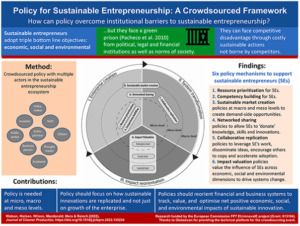How can policy help unleash the power of sustainable entrepreneurs?
09/03/2023

Entrepreneurs are typically cast as antagonists of “the system.” At the same time, the policy landscape has evolved to support them… so long as they maximise economic activity and growth. But what about the new breed of ‘sustainable entrepreneurs’ who seek to achieve social and/or environmental gains as well as profit? What current policies help them?
As we face the climate emergency, sustainable entrepreneurship has the potential to make a vital contribution to a viable future. These entrepreneurs are creating new rules for business that equally value environment, society and economy in their success metrics. They’re innovating around current market failings that cause detrimental impacts to the natural world and its citizens. Yet, this very approach of a bottom triple-bottom-line success can put them at a disadvantage in a competitive market that sustains the “business as usual” of profit-first thinking. They miss out on funding, face political inertia, navigate unknown legal spaces, and struggle against social scepticism. They exist in a “green prison” that puts them at a disadvantage for achieving both impactful change and economic viability.
In short, the current policy framework – made up of legislation, public funding, education systems, cultural expectations, citizen behaviours – doesn’t support the ecosystem of sustainable entrepreneurship.
So, what would a more supportive policy framework look like?
That is question that Dr Rosina Watson and colleagues[1] tackled during a novel crowdsourcing approach to policy research, published in the Journal of Cleaner Energy in 2022. As this is an area of research that has previously received very limited attention, we’re excited by both the findings and methods used.
The research proposes a toolkit for dismantling the prison bars through the power of co-creative policy ideation.
Sustainable Entrepreneurs and their connected stakeholders are the ones impacted by policy, so this research brought them into the conversation. It re-writes the story from them being system antagonists to collaborative innovators, not just of products and services, but also of the system itself
The crowdsourcing method took place online over one day. It brought together 150 entrepreneurs, management academics, policy makers, and other key actors in an online forum. It allowed people from different geographical locations to engage in conversations in real time. Instead of one person dominating a conversation, multiple organic discussions were able to emerge. Creativity was allowed to flow. Ideas were proposed. Blockages identified. Solutions formulated. All collaboratively by the people that policy actually impacts.
[1] Rosina Watson, Kristian Roed Nielsen, Hugh N. Wilson, Emma K. Macdonald, Christine Mera, Lucia Reisch.

From this wealth of data, a picture emerged of what a more supportive policy framework could look like. The six foundation blocks (and some rough suggestions of what that means in practice) are:
Resource Prioritisation
Getting the flow of funding and resource to the right places through government funding, investor incentives, or tax breaks, as examples.
Competency Building
Embedding sustainability into the education system from earlier points and encouraging cross-sector learning, such as through experience exchanges.
Sustainable Market creation
Levelling the playing field by making relevant externalities cost apparent, like plastic waste, means the green solutions are more appealing to investors.
Networked Sharing
Creating spaces (online and in person) for rewarding the sharing of knowledge, creating opportunities for connection, and encouraging innovative conversations.
Collaboration Replication
Amplifying impact and systems change through support for replicating ideas that work.
Impact Valuation
Re-orientating the financial system towards recognising and rewarding triple-bottom line performance
Implementing these blocks maximises the chances of sustainable entrepreneurs being able to thrive by creating a more inviting playing field.
These blocks in turn suggest a reframe of what the end goal for entrepreneurship policy should be.
Breaking this down, the three objectives should be:
Enterprise creation at the meso-level
Policy tends to support the individuals (micro) and create market opportunities (macro). Sustainable entrepreneurs cultivate their own mid (meso)-level ecosystem as they not only advance private interest but a public collective agenda leading to higher levels of collaboration and impact. Policy that understands the importance of nurturing this ecosystem is more successful.
System transformation through encouraging triple-bottom-line innovations
Innovation should be treated in a more open fashion. The object of sustainable entrepreneurship policy should be on sustainability-orientated innovation and how they are replicated, not just enterprises and how they are grown. It shifts from the traditional objective of exploiting an innovation to benefit the economy to progressing innovation to increase environment and social as well as economic value.
Impact re-orientation towards valuing economic, social and environmental success.
Forecasting, measuring, and reporting on environmental and societal impacts of sustainable entrepreneurship is critical. It helps prioritise the flow of funding to individuals. This creates models for measuring holistic success within industries and geographies. It generates markets for sustainable products and services that are priced by taking in externalities.
The ultimate takeaway from this research is that sustainable entrepreneurship can no longer be seen as a mere ‘subset’ of entrepreneurship. Especially when it comes to policy and research. For these entrepreneurs, it is not just the level of activity that matters; it is the maximum positive societal and environmental impact that can be made. Let’s re-write the story of entrepreneurs as system antagonists and celebrate them as collaborative system-changers. Letting them be co-creators in the Policy Landscape they operate in gives us the best chance of transitioning to a sustainable future.
What next? Dive deeper into the research methods, findings and suggestions for future research by reading the whole paper here.
Categories & Tags:
Leave a comment on this post:
You might also like…
Creating and using constituent lists in Datastream
Whether you're analysing industry performance, or comparing company financials, Datastream is a powerful tool. One of its most useful features is the ability to work with constituent lists — collections of companies grouped by index, ...
Landing at Cranfield: First-term experiences and life beyond the classroom
Starting a postgraduate course can feel daunting, especially if you’re new to the aviation industry. In this blog series, Adit Shah shares his journey on the Air Transport Management MSc at Cranfield. From first-term ...
Accelerating ambition: How Amelie Rohan engineered her future at Cranfield
In the world of high-performance automotive engineering, the gap between being a “fan” and being a professional is measured in more than just miles. It is measured in technical precision, hands-on ...
Study better and smarter in 2026
Happy new year! Now is the perfect time to reflect on your studies so far, thinking about what you’re doing well and where you need to focus a bit more attention. Getting back into ‘study ...
Cleared for the future: Why aviation leaders must embrace environmental sustainability
Environmental sustainability is not a niche concern for aviation anymore, it’s central to how we think about the future of our industry. In my work as an Associate Professor of Airport Decarbonisation, I see first-hand ...
Preparing your work for Turnitin submission
Before submitting your work into Turnitin for similarity checking, if you have used referencing software then you may need to take some important steps first. Mendeley and Zotero integrate with MS Word by embedding field ...







